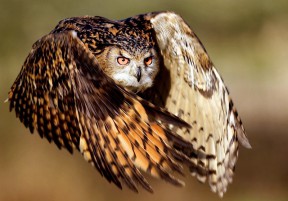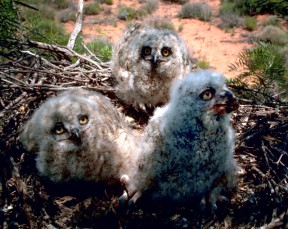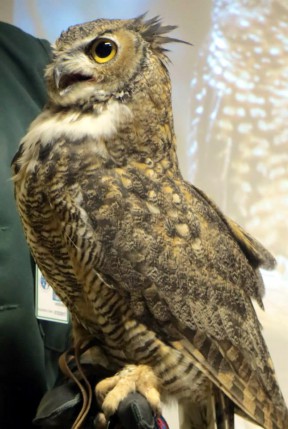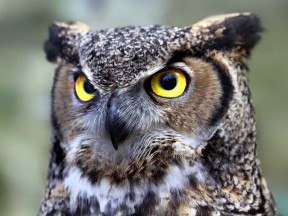 Why did we choose the great horned owl as our logo for the Placerita Canyon Nature Center? Owl Junior, who quickly became OJ, was our resident owl for 29 years. He was a beautiful bird that everybody admired, but he was cranky with people who fed the snakes in front of him and did not let them handle him.
Why did we choose the great horned owl as our logo for the Placerita Canyon Nature Center? Owl Junior, who quickly became OJ, was our resident owl for 29 years. He was a beautiful bird that everybody admired, but he was cranky with people who fed the snakes in front of him and did not let them handle him.
OJ was quiet for many years, but out of the blue, one day he figured how to hoot – and he kept on going with gusto until the end of his life.
When he died, we were all shocked and upset, but by looking at our logo, his presence will always remain with us.
The great horned owl is a bird of prey that commands respect.
The most striking feature of the great horned owl is its eyes: large and yellow, often staring at you, and placed in a facial disk that also helps to bring more sound to the ear openings.
Great horned owls have perfect auditory anatomy to help them hunt. The ear openings are on each side of the facial disk; this dish directs all of the sounds to the ears. The placement of the ears is asymmetric: The right ear is set higher up in the skull, and the left one is lower. By tilting its head, the owl can tell exactly the location of prey simply by sound. Experiments have been done in a totally dark room, and the great horned owl was able to catch a mouse even in that absolute darkness.
Great “horned” owl? Does it have horns? It has tuft of feathers on its head that moves up or down according to the owl’s mood. They are not horns, or even ears, but they give the great horned its distinctive appearance and a certain panache.
Let’s go back to their eyes. Owls have binocular vision, allowing them to pinpoint prey and see in very low light. The eyes are almost as large as human eyes, but they cannot move left and right. They are fixed in its head.
Would that be a problem if you tried to hunt? A human neck has seven vertebrae, and this is why we can turn our head just over our shoulder and no further. The owl has 14 vertebrae, so it can turn its head further to see what is at its back. We would have to turn our body around to be able to do that.
Many kids ask, “Can it turn its head all the way around?” No, but it can turn its head a long way to the left, then it can turn its head around to the right. With those two motions, it has seen all the way around.
On the other hand, the great own horned owl has a poor sense of smell, like most birds. This is beneficial if you want to eat something that doesn’t smell so nice, like a skunk - which they do without the slightest discomfort. They are actually the only regular predator of skunks; most other animals choose to stay away.
They are ferocious hunters and can easily kill prey two to three times heavier than they are. In addition to birds that they catch sleeping, and small mammals that come out at night, they can catch squirrels, chicken, fish, rabbits and even cats and small dogs.
If the prey is large, the owl will start eating it on the ground, but smaller prey is killed while taking off, and then swallowed whole. Its talons have 300 pounds of pressure per square inch (PSI), so no prey can escape. It has four toes on each foot and can rotate two toes to the front and two toward the back, which is a perfect position for squeezing a prey to death.
 How does it hunt at night? The great horned owl has a wing span of four feet, and its wings have stiff feathers. Even the feet are covered with feathers, so they fly without making a sound.
How does it hunt at night? The great horned owl has a wing span of four feet, and its wings have stiff feathers. Even the feet are covered with feathers, so they fly without making a sound.
It is always special to demonstrate this phenomenon at the Nature Center when we make the owl presentation. We ask the audience to be quiet, and we move our hand up and down so the owl perched on it has to move it wings to keep balanced. Not a sound can be heard, and that invariably astonishes the audience.
An owl hunts at night by observing from a concealed perch. It dives down on the prey, talons extended, and often with wings folded. The small prey is swallowed whole, and six to eight hours later, the owl will regurgitate a pellet with all of the parts that could not be digested, like bones and fur. It is always an interesting science project to dissect an owl pellet to find out what the owl diet was on a particular day.
Great horned owls mate for life, but they stay together only during the breeding season. They need a territory of about 2.5 acres, and they breed early in the year. Because they do their hunting at night, it is appropriate that they take advantage of the longest nights of the winter when they can hunt for an extended period of time. They breed in January and February, but they call for a mate in the fall and make a decision by December.
During courtship, the male will puff up and hoot loudly. The female will hoot back, and they rub beaks and preen each other. They do not build their own nests but take over the nest of a large bird such as a raven or hawk. Sometimes they use a cavity in a tree or an empty building.
Females will lay one to five eggs, and the incubation lasts about 33 days. The female is in charge of incubation and is fed by the male. When the babies are two weeks old, they are fed by both parents.
 The babies are curious and adventurous and start to check out the nearby branches when they are six weeks old, but they are not good flyers until they are 12 weeks old. They stay close to their parents even until the following October, when the parents are thinking about starting the new clutch. Parents’ jobs never stop, I guess, even among birds.
The babies are curious and adventurous and start to check out the nearby branches when they are six weeks old, but they are not good flyers until they are 12 weeks old. They stay close to their parents even until the following October, when the parents are thinking about starting the new clutch. Parents’ jobs never stop, I guess, even among birds.
For years, the great horned owl was considered a threat to small domestic fowl, and bounties were paid for a dead owl. Education has changed this sad perception. Public opinion has shifted; we have learned they keep the rodent population under control and play an important role in our environment. Trapping or hunting owls is now illegal.
The eggs, nestlings and fledglings can be eaten by coyotes or cats, but the adults have almost no predators, and the population remains stable.
October will be here soon, and with it, the beginning of the courtship season. I hope that while you’re lying in your bed in the quiet of the night, you can hear the hooting in a nearby tree. It is comforting to know wildlife is so close by, even if the great horned owl is well hidden and difficult to see in the dark shadows.
Evelyne Vandersande has been a docent at the Placerita Canyon Nature Center for 27 years. She lives in Newhall.
Placerita Mascot: The Great Horned Owl | Commentary by Evelyne Vandersande

